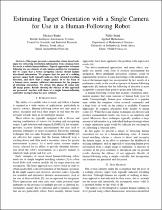 ResearchSpace
ResearchSpace
Estimating Target Orientation with a Single Camera for Use in a Human-Following Robot
JavaScript is disabled for your browser. Some features of this site may not work without it.
- ResearchSpace
- →
- Research Publications/Outputs
- →
- Conference Publications
- →
- View Item
| dc.contributor.author |
Burke, Michael G

|
|
| dc.contributor.author |
Brink, W

|
|
| dc.date.accessioned | 2010-12-06T12:39:34Z | |
| dc.date.available | 2010-12-06T12:39:34Z | |
| dc.date.issued | 2010-11 | |
| dc.identifier.citation | Burke, M. and Brink, W. 2010. Estimating Target Orientation with a Single Camera for Use in a Human-Following Robot. 21st Annual Symposium of the Pattern Recognition Association of South Africa. Stellenbosch, South Africa, 22-23 November 2010, pp 6 | en |
| dc.identifier.isbn | 978-0-7992-2470-2 | |
| dc.identifier.uri | http://hdl.handle.net/10204/4601 | |
| dc.description | 21st Annual Symposium of the Pattern Recognition Association of South Africa. Stellenbosch, South Africa, 22-23 November 2010 | en |
| dc.description.abstract | This paper presents a monocular vision-based technique for extracting orientation information from a human torso for use in a robotic human-follower. Typical approaches to human-following use an estimate of only human position for navigation, but the authors argue that a better navigation scheme should include directional information. The authors propose that the pose of a walking person’s upper body typically indicates their intended travelling direction, and show that a simple planar fit to the back of a human torso contains sufficient information for the purpose of inferring orientation. The authors obtain this planar fit using only 2D image points. Results showing the efficacy of this approach are presented, together with those of a simple human following controller incorporating the pose estimate | en |
| dc.language.iso | en | en |
| dc.publisher | PRASA 2010 | en |
| dc.relation.ispartofseries | Conference Paper | en |
| dc.subject | Mobile robot | en |
| dc.subject | Homography | en |
| dc.subject | Computer vision | en |
| dc.subject | PRASA 2010 | en |
| dc.subject | Monocular vision | en |
| dc.subject | Human following robot | en |
| dc.title | Estimating Target Orientation with a Single Camera for Use in a Human-Following Robot | en |
| dc.type | Conference Presentation | en |
| dc.identifier.apacitation | Burke, M. G., & Brink, W. (2010). Estimating Target Orientation with a Single Camera for Use in a Human-Following Robot. PRASA 2010. http://hdl.handle.net/10204/4601 | en_ZA |
| dc.identifier.chicagocitation | Burke, Michael G, and W Brink. "Estimating Target Orientation with a Single Camera for Use in a Human-Following Robot." (2010): http://hdl.handle.net/10204/4601 | en_ZA |
| dc.identifier.vancouvercitation | Burke MG, Brink W, Estimating Target Orientation with a Single Camera for Use in a Human-Following Robot; PRASA 2010; 2010. http://hdl.handle.net/10204/4601 . | en_ZA |
| dc.identifier.ris | TY - Conference Presentation AU - Burke, Michael G AU - Brink, W AB - This paper presents a monocular vision-based technique for extracting orientation information from a human torso for use in a robotic human-follower. Typical approaches to human-following use an estimate of only human position for navigation, but the authors argue that a better navigation scheme should include directional information. The authors propose that the pose of a walking person’s upper body typically indicates their intended travelling direction, and show that a simple planar fit to the back of a human torso contains sufficient information for the purpose of inferring orientation. The authors obtain this planar fit using only 2D image points. Results showing the efficacy of this approach are presented, together with those of a simple human following controller incorporating the pose estimate DA - 2010-11 DB - ResearchSpace DP - CSIR KW - Mobile robot KW - Homography KW - Computer vision KW - PRASA 2010 KW - Monocular vision KW - Human following robot LK - https://researchspace.csir.co.za PY - 2010 SM - 978-0-7992-2470-2 T1 - Estimating Target Orientation with a Single Camera for Use in a Human-Following Robot TI - Estimating Target Orientation with a Single Camera for Use in a Human-Following Robot UR - http://hdl.handle.net/10204/4601 ER - | en_ZA |






